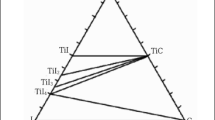Conclusions
-
1.
A study was made of the oxidation of titanium carbide in an oxygen atmosphere at pressures of 10−5, 10−1, 10, and 150 mm Hg in the temperature range 500–1000°C.
-
2.
As a result of x-ray diffraction, metallographic, and electron microscopical investigations it has been established that the implantation of oxygen in the carbide lattice is accompanied by the precipitation of carbon and metallic titanium. The amount of metallic titanium precipitated grows with rise in temperature and oxygen pressure.
Similar content being viewed by others
Literature cited
R. F. Voitovich and É. A. Pugach, “High-temperature oxidation of titanium carbide,” Poroshk. Metall., No. 2, 63–68 (1972).
R. F. Voitovich, “An investigation into the high-temperature oxidation of alloys of transition metal and their refractory compounds,” Doctoral Dissertation, Kiev (1975).
R. F. Voitovich and É. A. Pugach, “Some features of the oxidation behavior of Groups IV–VI metal carbides,” in: Carbides and Their Alloys [in Russian], Naukova Dumka, Kiev (1976), pp. 233–234.
G. D. Bogomolov, S. I. Alyamovskii, et al., “Some structural characteristics of cubic titanium oxycarbide,” Izd. Akad. Nauk SSSR, Neorg. Mater.,6, No. 8, 1405–1408 (1970).
S. I. Alyamovskii, E. N. Shchetnikov, et al., “Completeness of the lattices of titanium and vanadium oxycarbides and oxynitrides,” Izd. Akad. Nauk SSSR, Neorg. Mater.,5, No. 7, 1210–1214 (1969).
L. Kh. Pivovarov, E. Ya. Vrzhets, et al., “Vacant points in the TiC—TiO crystal lattice,” Zh. Neorg. Khim.,12, 1743–1750 (1967).
S. I. Alyamovskii, Yu. G. Zainulin, et al., “Effect of composition on the completeness of the elementary cells of cubic titanium and vanadium oxycarbides,” Zh. Neorg. Khim.,15, No. 12, 3171–3177 (1970).
V. A. Zhilyaev, Yu. G. Zainulin, et al., “High-temperature oxidation of zirconium and hafnium oxycarbides, oxynitrides, and oxycarbonitrides,” Poroshk. Metall., No. 8, 38–43 (1972).
V. A. Zhilyaev, V. D. Lyubimov, and G. P. Shveikin, “Mechanism of the phase transformations occurring during the oxidation of TiC in air,” Izd. Akad. Nauk SSSR, Neorg. Mater.,10, 47–52 (1974).
H. Bilz, “Über Elektronenzustände von Hartstoffen mit Natriumchloridstruktur,” Z. Phys.,153, 338–358 (1953).
S. P. Denker, “Relation of bonding and electron band structure to the creation of lattice vacancies in TiO,” J. Phys. Chem. Solids,25, 1397–1405 (1964).
P. V. Gel'd and V. A. Tskhai, “Mean densities of valence electrons in FeOx, YOx, and TiOx,” Zh. Struk. Khim.,4, 235–244 (1963).
G. F. Mocharnyuk, “Structural characteristics of cuprous oxide and some complex semiconductor systems,“Candidate's Dissertation, Lvov (1963).
A. L. Lasker, Indian J. Phys.,36, No. 7, 359–361 (1962).
N. Cabrera, “Development of etch pits and oxidation centers on dislocations,” in: Elementary Crystal Growth Processes [Russian translation], IIL, Moscow (1959), pp. 166–174.
J. P. Hirth, “On dislocation interactions in the fcc lattice,” J. Appl. Phys.,32, No. 4, 700–706 (1961).
F. W. Young and A. G. Gwatmey, “Development of facets, spirals, and etch pits on copper crystals by heating to high temperatures in high vacua,” J. Appl. Phys.,31, No. 2, 225–230 (1960).
F. F. Lavrent'ev, L. M. Soifer, and V. I. Startsev, “Thermal etching and annealing of twin interlayers in antimony crystals,” Kristallografiya,5, No. 3, 472–475 (1960).
A. I. Andrievskii and G. F. Mocharnyuk, “Bringing out dislocations on cleavage planes in cuprous oxide,” Kristallografiya,8, No. 5, 793–795 (1963).
N. V. Ageev, V. A. Reznichenko, et al., “Lower titanium oxides,” in: Titanium and Its Alloys [in Russian], Vol. 11, Izd. Akad. Nauk SSSR, Moscow (1959), pp. 64–72.
N. E. Filonenko, V. N. Kudryavtsev, and I. V. Lavrov, “Titanium oxides in the TiO2-Ti2O3 range,” Dokl. Akad. Nauk SSSR,86, No. 3, 561–564 (1952).
Author information
Authors and Affiliations
Additional information
Translated from Poroshkovaya Metallurgiya, No. 3(183), pp. 55–61, March, 1978.
Rights and permissions
About this article
Cite this article
Voitovich, R.F., Golovko, É.I. Oxidation of titanium carbide at various oxygen pressures. Powder Metall Met Ceram 17, 211–216 (1978). https://doi.org/10.1007/BF00791431
Received:
Issue Date:
DOI: https://doi.org/10.1007/BF00791431




